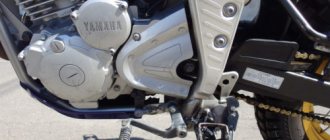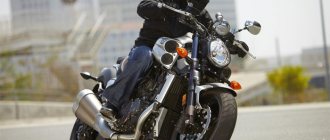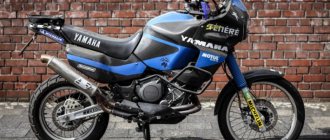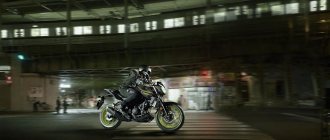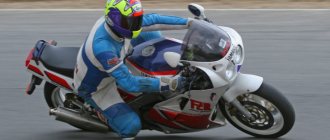This sports motorcycle is called a legend by many. This is not surprising, because, having started to graduate several decades ago, he was able to show results that many of his modern classmates are unable to achieve.
Yamaha UZF R1 is a motorcycle that has become a dream for many riders, because they are tired of low-quality equipment that is not particularly durable and repairable. This bike looks great and has excellent features. In a word, even if the motorcycle is discontinued, it will probably be sold secondhand on the secondary market for a long time.
Brief history of creation
The Yamaha R1 motorcycle dates back to the 1988 FZR1000 model, which introduced a number of major updates to the entire segment, including a lightweight aluminum DeltaBox frame, increased engine power, and a 5-valve cylinder. Improved handling and braking performance.
Then, 4 years later, an intermediate version of the CBR900RR Fireblade sports motorcycle was released, the model immediately became popular in its environment. Although it was a less powerful version of the FZR1000, it weighed less and had shorter dimensions.
It took a lot of time to finally refine the handling and dynamics of Yamaha motorcycles, so the P1 was released back in 1998.
The blue version was an incredible success among amateur racers.
Over the course of 15 years, the Yamaha R1 model has undergone significant changes, both in technical equipment and in terms of engine power. For example, in 2000, the body became more rapid and aggressive in shape, with better streamlining, increasing speed and reducing resistance.
Motorcycle review. The bike is not for dummies.
This is a racing motorcycle designed for the track, for speed and only speed. With its sharp nose and light tail, the Erka resembles a space object, however, the bike can be identified even from afar and against the sun - Yamaha has remained true to itself. However, unlike the previous model: “hard”, brutal, the 2012 bike turned out to be more “sleek”.
The first thing that catches your eye is the seat. It is placed quite high, while other sportbikes have it lower. In reality, this gives additional opportunities to control one’s own body. Its tilt changes the trajectory and helps you take turns more accurately. True, this feature of the bike can play a cruel joke on a non-professional... But the Erka is not a machine for dummies...
Absolutely not for dummies! The bike reacts to the throttle not even like a dog that has finally been let off the chain, but like a projectile that was fired from a catapult - a hundred from first gear is normal. The maximum speed of the Yamaha R1 is 300 km/h!
It is clear that with such agility, the braking system must be very competent. “Special thanks to the designers” for it - on the track it works extremely effectively, providing safe braking at any speed: on a sharp turn after a straight section this is a big bonus for the racer.
In general, turns are the “strong point” of this bike, and the aluminum diagonal frame plays a significant role in this. It is light and, at the same time, tough. When cornering, when the suspension can no longer cope, it is the frame that takes the main load. This one does the job, while at the same time providing the bike with absolutely incredible handling.
Another pleasant point is the smooth gear shift without sudden jerks . At speeds that the motorcycle is capable of reaching - up to 300 km/h, this feature not only saves time, it can save lives. For comparison, the maximum speed of the Yamaha R6 is 265 km/h.
Of course, there is no question of any comfort here. The extremely stiff suspension will make you literally “feel” the track with your whole body. But the rider must feel the track!
Another very interesting motorcycle from the land of the rising sun: the Honda CBR600RR, the technical characteristics of which will appeal to many motorsport connoisseurs.
Do you want your children to engage in motorsports? We can help you decide on the choice of a children's gasoline motorcycle.
Yamaha P1 technical specifications
Length – 207 cm;
Width – 71.5 cm;
Height – 113 cm;
Ground clearance – 13.5 cm;
With a total weight of 206 kg.
Engine
The engine features a MotoGP-derived crankshaft in a 998 cc inline-four. See: Uses Yamaha's exclusive crankshaft technology developed from the YZR-M1 MotoGP. Every millimeter of this unique engine is designed to deliver thrills, and by 2022 a new cylinder head, intake system, and fuel injectors will be added.
The design of the bike is made in a sporty style
The Yamaha P1 features Yamaha's new wireless Controlled Throttle (YCC-T) system, which converts rider input into motion, with a full suite of IMU-based electronic rider aids. New electronic features provide even greater control and control.
Yamaha created the first serial production product in the history of motorcycle construction with characteristics similar to those of the P1.
The Yamaha P1 clutch has a multi-plate clutch. Because of the ambidextrous quickshifter, you can change gears without pressing the clutch, which helps reduce lap times.
Capacity and power
The power of the Yamaha P1 is truly enviable; the maximum power is 147.1 kW. with a displacement in Yamaha P1 of 998 cubic meters.
Sports transmission
The 6-speed transmission perfectly matches the explosive engine, providing quick revs and optimal power and traction delivery. Japanese engineers managed to improve the weight distribution of the motorcycle due to the pyramidal arrangement of the input and output shafts of the gearbox, which made the R1 engine shorter.
You can envy the power of the Yamaha P1
Upgraded brakes
The YZF-R1 uses track brakes featuring powerful 4-piston radial front calipers, stainless steel front guides, large 320mm rotors with new high-friction pads and an all-new compact ABS unit. The new Bridgestone RS11 tires provide excellent grip and balanced road feel and handling.
Yamaha has a top-end modification with 4-piston radial calipers on the front brake. And braking accuracy is calculated by the ABS Unified Braking System, developed specifically for motorcycle racing. The system prevents the rear wheel from slipping during heavy braking and integrates with the overall IMU system when calculating the optimal loads on the brake calipers.
Fuel consumption
Fuel consumption is about 7.2 liters per 100 km.
Carburetor
The Yamaha P1 carburetor has a new fuel injection system, which increases the speed.
The price is related to the year of manufacture of the motorcycle.
Last generation
The most recent improvement occurred in early 2022. At the moment, this is the first prototype of the modification, the output of which is equal to 200 horsepower. It’s still difficult to say whether the new product is a successful embodiment of engineering ideas, since there are still too few reviews about the bike.
But already from the horse’s mouth there is praise towards the manufacturer. After all, the designers managed to significantly improve the characteristics of the Yamaha R1: reduce not only the consumption, but also the weight of the motorcycle. You will also be pleased with the improved equipment and a more intuitive level of controllability.
Previous post Which scooter do you need a license for and how to get one?
Next entry Review of Yamaha ybr 125 technical specifications
Average cost of a motorcycle and annual maintenance
How much a Yamaha P1 costs is directly related to the year of manufacture of the motorcycle; the newer it is, the correspondingly higher the cost. For example, this year’s model will cost 1,800,000 thousand rubles; for older versions the price is reduced. It is also possible to buy a motorcycle through sites selling used goods, but there is a danger of running into a low-quality product, without documents, with faults, and so on.
Therefore, it is better to legally purchase motorcycles from previous years of production.
Annual maintenance of a top-end motorcycle will also not be cheap. Consumables, not counting gasoline, cost about 20,000-30,000 thousand rubles per season.
Externally, the Yamaha R1 turned out to be much more attractive than the photos on the Internet; moreover, the developers of the Yamaha motorcycle did their best, concentrating their attention not only on the design of the motorcycle, but also on the practicality of assembling individual parts of plastic, etc...
The front part of the motorcycle
The little face turned out to be very friendly and compact. In the new R1 model, the optics have undergone significant changes. In the 2009-2010 version, the headlights became open. The protective glass and inertial inflation, which was located under the headlights on the previous model and took its secret place next to the headlights in the new version, were removed from the headlights of the motorcycle. The shape of the headlights is convex, with lenses made of thick glass, so that when traveling, flying stones from cars in front do not break them. There are also marker lights along the edges of the inflator. The quality of light is amazing! Many of us prefer to immediately install xenon in stock versions of motorcycles, but in the new R1, despite the fact that the headlights have ordinary lamps, they are almost worse than xenon. We parked 2 motorcycles side by side at night and compared the effect. Let's just say that installing xenon on this motorcycle will not bring any better effect other than a bright, caustic light. Yes, and we can leave this point in question, because... Driving with high beams in the daytime doesn’t just visually show the motorcycle well, but even blinds drivers (I was convinced from personal experience by calling a passing friend asking them to turn off the high beams :))! At night, when driving on the highway, you can safely compete with your high beams with oncoming cars. There are often situations when drivers forget to turn off the high beams, turn on the high beams and interrupt the oncoming flow of light with a bang!
The windshield mount remains unchanged in the new version. The absence of glass fastening bolts on plastic cannot but rejoice. Everything is beautiful and elegant. The shape of the glass is short, it handles the oncoming air flow well, although at first glance it is intimidating with its size. You can replace it with a “humpback” one for more comfortable everyday driving, which is what we did.
The color of the inverted front fork easily reveals the origin of the motorcycle. In the American version the color of the glasses is golden, and in the European version it is black. The brakes of the new era are very effective. At the front of the motorcycle there is a Brembo brake machine and 2 calipers with 3-piston calipers, as far as I understand NESIN, which is also quite good. After a short test, experienced jet riders were pleasantly surprised by the brakes and started thinking about installing them on their motorcycles. Out of curiosity and the chance to improve braking performance even further, we installed reinforced brake hoses from HEL. The result exceeded expectations. A light touch of one finger to the brake lever and the motorcycle stops dead in its tracks, but here you have to be more vigilant, because... Pressing the brake too hard will lead to your first stunt riding lesson :).
Driver's seat
The dashboard pleasantly surprised us with its capabilities, flexible settings and information content. The large display does not strain the pilot’s eyes and makes it possible to clearly see what is happening on the display with peripheral vision without being distracted from piloting. The gear indicator is a very useful new feature that is also present in the new R1 and unfortunately missing in the 2007-2008 model. The American version of the motorcycle also has disadvantages compared to the European version. It is possible to switch the dashboard indicators from miles to kilometers, but the engine temperature is displayed only in Fahrenheit and does not show in Celsius, which is very inconvenient, but already familiar. An option to solve the problem, if you have an American version of a motorcycle, is to order a dashboard from a European. I haven’t experimented with this stuff yet, but there is interest in the future. There is no “wink” button on the left turn control remote control in the American version. This is really a minus, because... I used this button all the time on my previous motorcycles. Again, everything can be fixed by ordering a European remote control, but if you have a version of the Yamaha YZF-R1 from Europe, you have nothing to worry about! Also, the turning lever is too soft. The turn signal turns on clearly, but you can’t always put your finger on it to turn it off. Perhaps time will correct this shortcoming, but I personally didn’t have any misfires on the same SUZUKI. By the way, about turn signals. In the American version they are very big, like paws :). Also, in comparison with the European version of the Yamaha YZF-R1 motorcycle, when the ignition is turned on, the side signal lights up (only at the front) - this point can be attributed to the advantages of the Americans rather than the disadvantages. The seats remained oval-shaped. This is not very good if you want to replace the turn signals with more elegant ones. Here you will have to buy all sorts of adapters, in a word - something tricky. When driving at 200 km/h, the air flow pulls the rear turn signals out of their seats. Also, due to the high resistance, they begin to rock the motorcycle shovel. There is a good elegant alternative to these turn signals, which I will write a separate post about. When the R1 appears in the rear-view mirrors, the guys confuse it with a goldwing, which glows from all sides, and with its headlights it shines through like a spotlight!
The low beam is always on, but only after the engine starts. When muted, it is inactive. Alternatively, you can start the motorcycle and immediately turn it off if you need to brighten up something. On the highway at night, this option is not very convenient, because... The motorcycle key will have to be left in the ignition, i.e. There are no parking lights or key positions in the new R1.
On the right remote control there is a classic set of “start”, “stop engine” and a mode switch (A, STD, B). A new feature that has long been used in SUZUKI motorcycles. By default, the STD mode is always turned on - the average urban mode, and perhaps the disadvantages include the fact that if you are interested in constantly riding in mode A or B, then every time you turn off the motorcycle it goes into the average mode, i.e. the position is not remembered. The STD mode in terms of power can be classified as a motorcycle of the 750cc class, somewhere between 600cc and 1000cc, however, less susceptible to provocations of “goat” in comparison with a motorcycle of the pure 750cc class.
“B” – rain riding mode, the so-called strangled mode, equal in power to a 600cc class motorcycle. In this mode, the throttle is more gentle, one might say it falls down and the motorcycle smoothly picks up speed. In this mode, driving in the rain is very comfortable, the chances of the rear wheel breaking off in the axle box are zero. This mode can also be useful for a beginner who is ready for a 600cc class motorcycle, but is still afraid to take a liter. In “B” mode, driving is absolutely safe.
“A” is the most sporty aggressive mode, in which the motorcycle turns into an angry beast. Yamaha, in its coverage of the motorcycle, claimed that this version of the motorcycle contains minimal throttle response delays and promotes full interaction between the rider and the rear wheel of the motorcycle. Justified! You can feel it! The gas becomes very sensitive and must be played with extremely carefully. We will return to this mode in the final third part of the review, where I will write a report on the test drive of the motorcycle.
In general, fathers say that switching engine modes is a useless thing. Because If you don’t know how to ride a liter motorcycle, don’t get on it. I would like to refute this point of view a little, because... On modern sports motorcycles you can already install ABS and traction control, etc. As they say - to each his own. By the way, Yamaha continued the series of this motorcycle in 2011 and the only changes will be the graphics of the motorcycle and the installed traction control.
The lack of an emergency signal was also disappointing. Why it was not added is unknown. SUZUKI motorcycles are doing great in this regard.
Plastic inertial inflation linings consist of three parts. Honda motorcycles are doing much better in this regard. The motive for creating just such a design is still unclear to me, but I’ll figure it out in the future. The side plastic is easy to dismantle and consists of four parts. There's a whole symphony underneath. Everything is harmoniously packaged and in its place. When replacing the oil filter, it is a little inconvenient to remove the old one and install the new filter.
The driver's seat and driving position in general were very pleasing. This is my first time riding a sports motorcycle, which does not tire my back and arms. The seat is large and soft. With my height of 185 cm, my legs feel comfortable on the footrests, and my knees do not rest against the plastic. (I don’t know what the journalists from some magazines who sandboxed the landing didn’t like).
There is a proper battery mount under the seat, and a small set of vital tools is also hidden. To be honest, I don’t want to reveal it. All the keys are so compacted that putting them back in would make you look old. The workmanship of the tool itself is rare G..., it may be worth replacing some keys with more branded ones, but this concern falls on the shoulders of the buyer, but in vain. Unfortunately, things are not going well with the rear passenger seat. It is very small and hard. The passenger is forced to hang onto the driver, because the rear of the motorcycle is raised very high, and it won’t be very pleasant to feel a real bench in the butt! I don’t know how Andryukha Barmaley survived our trip to Odessa, we can safely give him a medal! Under the passenger seat you can tell you don't have a trunk! According to the manual, 1 kg will fit in there, and it’s not clear what? You won’t be able to fit anything there other than a woman’s cosmetic bag, although maybe a rag or a very compact cover for a motorcycle.
We smoothly approached the back of the motorcycle.
The plastic has become sharper, more expressive. The exhaust system is also located classically under the seats. Pipes of a similar design from 2007-2008, however, have a more massive appearance and are somewhat reminiscent of the Honda VFR800. The material from which the pipes are made both inside and outside is titanium. This is a positive benefit of durability. Despite the fact that titanium is a fairly light material, this design weighs a little, 15 kg, but it provides a high center of gravity, which is very useful in corners. You can lighten the motorcycle by installing tuning slips, but not by much. The maximum you can win is 2-3 kg. There is a good option for removing the short one from under the plastic, but it also has its drawbacks (I’ll write a separate post). The brake light is made of LEDs and looks much better than the 2007-2008 R1 version. The shovel is placed further behind the wheel so that dirt does not get thrown onto the back (the short tail from the Rottweider). We experimented and made our own short frame for the number, but the first trip showed that not only the entire back would be covered in dirt, but also the plastic, which would be covered in a thick layer of dirt and, in turn, spoil it. As a way out of the situation, you can change the frames in different weather, but then you will have to have a couple of spare turn signals and struggle with connecting them, because... There is very little space in the trunk for XL size hands :). To sum up the second part, I would like to say that the motorcycle is still made of very high quality. Every joint, every bolt is perfectly straight. I myself am a very picky person when it comes to expensive things, and moments when something is uneven or lags somewhere start to bother me. The new Yamaha YZF-R1 does not have these moments!
Main modifications of Yamaha YZF-R1
There are 3 different versions of the moto. The first is in the regular P1 configuration, the second is P1m in the more expensive track version. The main difference is the presence of a 6-piston brake. It also adds electronic suspension, an aluminum fuel tank, carbon fiber bodywork and racing tires.
The third configuration, P1c, was released in a civilian version and its cost is lower than usual. It adds aluminum wheels, steel cranks and no quickshifter, simpler tires, and slightly more torque.
General maintenance guidelines can be found in documents or manuals for the Yamaha P1.

